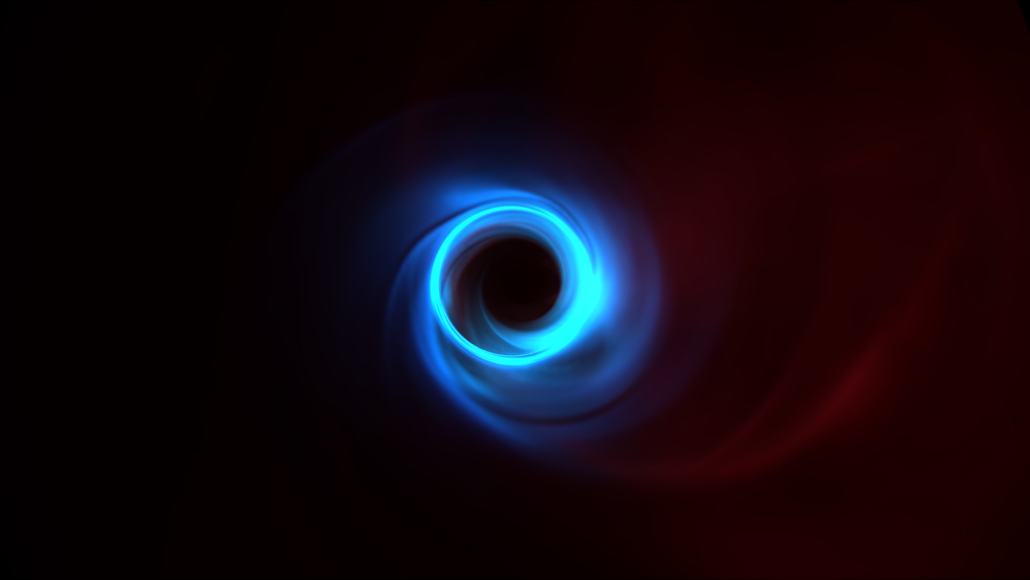
Simulations of the way light and matter move around the supermassive black hole at the center of galaxy M87, like the one shown here, helped physicists pin down the size of the shadow the black hole casts on surrounding material. That size is crucial in tests of general relativity.
L. Medeiros
- More than 2 years ago
When the first-ever image of a black hole was released in April 2019, it marked a powerful confirmation of Albert Einstein’s theory of gravity, or general relativity.
The theory not only describes the way matter warps spacetime, but it also predicts the very existence of black holes, including the size of the shadow cast by a black hole on the bright disk of material that swirls around some of the dense objects. That iconic image, of the supermassive black hole at the center of the galaxy M87 about 55 million light-years away, showed that the shadow closely matched general relativity’s predictions of its size (SN: 4/10/19). In other words, Einstein was right — again.
That result, reported by the Event Horizon Telescope Collaboration, answered one question: Is the size of M87’s black hole consistent with general relativity?
But “it is very difficult to answer the opposite question: How much can I tweak general relativity, and still be consistent with the [black hole] measurement?” says EHT team member Dimitrios Psaltis of the University of Arizona in Tucson. That question is key because it’s still possible that some other theory of gravity could describe the universe, but masquerade as general relativity near a black hole.
In a study published October 1 in Physical Review Letters, Psaltis and colleagues have used the shadow of M87’s black hole to take a major step toward ruling out those alternative theories.
Specifically, the researchers used the size of the black hole to perform what’s known as a “second-order” test of general relativity geared toward boosting confidence in the result. That “can’t really be done in the solar system” because the gravitational field is too weak, says EHT team member Lia Medeiros of the Institute for Advanced Study in Princeton, N.J.
So far so good for relativity, the researchers found when they performed this second-order test.
The results are on par with those from gravitational wave experiments like the Advanced Laser Interferometer Gravitational-Wave Observatory, which has detected ripples in spacetime from the merger of black holes smaller than M87’s (SN: 9/16/19). But the new study is interesting because “it’s the first attempt at constraining a [second-order] effect through a black hole observation,” says physicist Emanuele Berti of Johns Hopkins University, who was not involved in the new work.
Generally, physicists think of general relativity as a set of corrections or add-ons to Isaac Newton’s theory of gravity. General relativity predicts what those add-ons should be. If measurements of how gravity works in the universe deviate from those predictions, then physicists know general relativity is not the full story. The more add-ons or factors added to a test, the more confidence there is in a result.
In weak gravitational fields, like within the solar system, physicists can test whether “first-order” additions to Newton’s equations are consistent with general relativity or not. These additions are related to things like how light and mass travel in a warped spacetime, or how gravity makes time flow more slowly.
Those aspects of gravity have been tested with the way stars’ light is deflected during a solar eclipse for example, and the way laser light sent to spacecraft flying away from the sun takes longer than expected to return to Earth (SN: 5/29/19). General relativity has passed every time.
But it takes a strong gravitational field, like the one around M87’s black hole, to kick the tests up a notch.
The new result is slightly disappointing for the physicists hoping to find cracks in Einstein’s theory. Finding a deviation from general relativity could point the way to new physics. Or it could help unite general relativity, the physics of the very large, and quantum mechanics, the leading theory that describes the physics of the very small, like subatomic particles and atoms (SN: 3/30/20). The fact that general relativity still refuses to bend is “worrying for those of us who are old enough that we were hoping to get an answer in our lifetime,” Psaltis says.
But there is some hope that general relativity might still fail around black holes. The new study makes the box of possible ways for the theory to break down smaller, “but we haven’t made it infinitesimal,” Medeiros says. The study is “a proof of concept to show that the EHT could do this… But it’s really just step one of many.”
Future observations from the EHT will make for even more precise tests of general relativity, she says, especially with yet-to-be-released images of Sgr A*, the black hole at the center of the Milky Way. With much more precise measurements of Sgr A*’s mass than any other supermassive black hole, that image may make the possible box around the theory even smaller — or blow it wide open.







